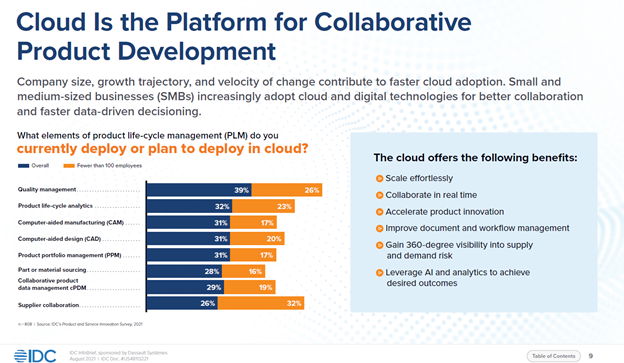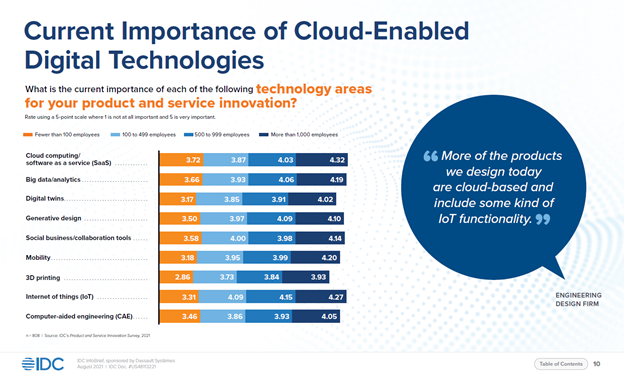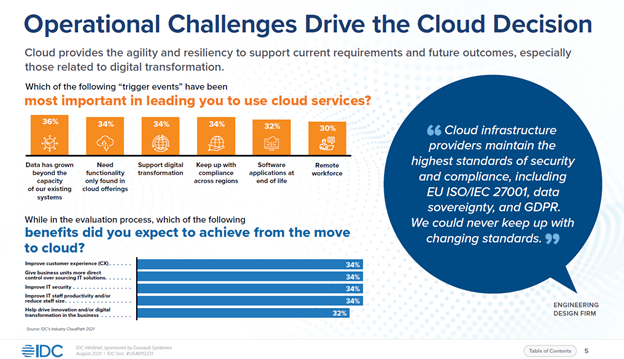Cloud CAD Isn’t Brand New
Cloud CAD has been available for some years through various SaaS applications such as OnShape and AutoCAD’s Fusion 360. But the choice of a MCAD application can be personal for an engineer. Also, many companies standardize on a CAD tool of choice and require all engineers on staff to use it. Many of those CAD apps require installation on a device, and are not available as SaaS software.
Cloud Provides Benefits For Engineering
Yet it’s clear from all sorts of data, that moving to the cloud is preferable (in many cases) to using on-prem software. A recent IDC InfoBrief published last year (sponsored by Dassault), “Accelerate Business Value by Moving to the Cloud,” clearly advocates cloud based computing. While the title was somewhat generic, the study focused on engineering software and platforms.
The IDC article presented interesting engineering and manufacturing data, selected from various other IDC surveys and reports. It highlighted an acceleration of movement to the cloud since the pandemic. I thought this chart was interesting:

Roughly, the percentage of companies currently or planning to deploy these engineering-related workloads to the cloud was only in the 20-30% range. In terms of CAD, it was 20% for small companies, and 31% overall.
I found that to be surprisingly low, particularly when you look at the data from this next chart:

Oddly, the same mid-market companies ranked technology areas such as digital twins, IoT, Big data/analytics at around 4 out of 5 in importance for their product/service innovation. Each of these technology areas would be very difficult to implement without cloud computing.
So there is a disconnect between the smaller percentage of companies moving engineering workloads to the cloud, and the large importance they assign to technologies that typically require cloud computing. It appears that product development teams recognize the critical importance of these new digital technologies. However, they are still reluctant to trust the cloud.
Operational Challenges Helped By Cloud
Another very helpful chart was the chart depicting how cloud helped the product development business from an operational perspective.

Data growth, an increasing number of remote workforce, and digital transformation all stood out as key trigger events for the decision to move workloads to the cloud. Companies expect quite a number of benefits from these cloud moves that include improved security, increased IT efficiency, and increased control by business units over their IT solutions.
SPK’s vCAD
These operational challenges, and these benefits, are the same ones we saw which caused SPK to develop vCAD. Small engineering teams or startup teams can more easily adopt a SaaS CAD software offering and enjoy the benefits of cloud CAD. However, there are many companies and engineers who have invested years using popular CAD applications like SolidWorks or Creo. It might be impossible or difficult to switch.
For those who can’t or won’t switch, we developed a cloud platform that provides similar benefits, while allowing one to keep their favorite design application. It serves a remote engineering workforce easily and quickly. It improves IP protection. It provides better IT security. It gives Engineering direct control over its CAD solution. It takes much less time, money, and IT resources to deploy a design desktop. When coupled with PDM in the Cloud, it provides analytics dashboards highlighting engineering metrics and KPIs.
The traditional model of a CAD application running on a desktop is straightforward and easy. It’s familiar. Everyone understands how it works. Yet, the new model of CAD running on cloud resources opens up many opportunities for better collaboration, efficiency, security, and ease of use.






